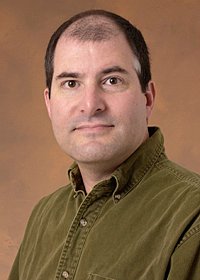


When Brian isnt managing and creating software to sequence and control robots on Mars he enjoys driving them. Brian has 20 years experience creating ground control software for planetary robotic vehicles and was the lead Rover Driver for both the Mars Pathfinder Sojourner Mission and the Mars Exploration Rover Mission.
M.S. in Computer Engineering University of Southern California 1985
B.S. in Electrical Engineering University of California at Irvine 1981
Jet Propulsion Lab 1985 to present:
- Program Element Manager for the Ground Control Station Software system for the ATHLETE (All Terrain Hex-Legged Extra-Terrestrial Explorer) Rough and Steep Lunar Rover Project.
- Cognizant Engineer and Cost Account Manager for development of RSVP for the Mars Science Laboratory (MSL) Mission to Mars. RSVP will be used to drive the vehicle and arm subsystem on the surface of Mars as well as to create all command sequence for this mission.
- Cognizant Engineer and Cost Account Manager for development of RSVP (Robotic Sequencing and Visualization Program) for the Phoenix Mission to Mars. RSVP will be used to control the robotic arm on the Phoenix Lander and to create all command sequences for this mission.
- Lead Rover Planner (rover driver) for the Mars Exploration Rovers. He is responsible for putting the team of rover drivers together and for their initial training. As rover driver he is responsible for creating all command sequences to move a rover across the surface of Mars and for controlling the robotic arm for instrument placement and Science gathering.
- Cognizant Engineer for the development of RSVP (Robotic Sequencing and Visualization Program). This software system is currently being used to create all command sequences for both Mars Exploration Rovers on the surface of Mars and is used to visualize the surface in 3D stereo and used to validate all robotic motions of the rovers before sending them up to the vehicles.
- Team leader for Advanced Rover Control Workstation (RCW) development for Mars Surveyor 2001 project and Mars Sample Return 2003 & 2005 projects. This system was designed to be portable to many computer systems and utilized the latest in computer graphics visualization techniques. It was multi-mission capable and provided identical user interfaces for both the operations teams and the mission scientists using the APEX and ATHENA instruments suites.
- Member of Mars Pathfinder Operations Team as primary Rover Driver. Has the honor of being the first person to ever drive a robotic vehicle on the surface of another planet.
- Created the Rover Control Workstation (RCW) for the Mars Pathfinder Sojourner Microrover. This software system consisted of 80 thousand lines of C++ code and was used to control every aspect of Soujourners daily operations. It provided the user with a clean Motif based GUI interface for every command in Sojourners command dictionary. It provided several unique interfaces for the commands related to rover motion. It used a virtual reality type interface for flying though computer generated terrain models of Mars and to designate waypoints for rover control. It also used the very latest incarnation of human stereo-based "Computer Aided Remote Driving" techniques as the primary method of driving the Sojourner on the surface of Mars.
- Conceived, designed and created a unique robotic vehicle control workstation consisting of a SGI 310VGX with Stereo display and Spaceball input. Stereo video images from cameras on a vehicle were transmitted over microwave link, input to the IRIS through VideoLab, and displayed in stereo. A calibrated, texture-mapped 3-D vehicle model in motion was used to designate b-spline shaped paths and control waypoints. The Spaceball was used to control the model movement in three space which corresponded to vehicle movement in the real world. This variant of a Virtual Reality system was used to control a multi-million dollar suite of U.S. Army robotic vehicles in precursor proof-of-concept missions to explore the planet Mars. Provided customer training and support to sponsors on our robotic vehicle control workstation. In-field demonstrations and guidance on the use and maintenance of this custom (SGI-based) control station enabled the successful completion of critical Army and contractor milestones at Aberdeen Proving Grounds, MD.
- Manager of Computer Vision, Robotic Vehicle Mobility and Guidance, and Data Management subsystems of the Army sponsored Robotic Technology Test Vehicle Program (RTTV). Designed, tested and managed all software and hardware components for these three critical subsystems and was responsible for their integration into the final RTTV system.
- Responsible for control software design and implementation for Mars prototype robotic vehicle. Integrated state-of-the-art machine vision techniques to guide robotic vehicles with semi-autonomous teleoperation (Computer Aided Remote Driving).
- Performed research on global route planning algorithms in support of Army route planning development workstation.- Co-authored software users guide for Symbolics 3670-based workstation to facilitate development of automatic route planning algorithms for autonomous land vehicles.
U.S. Air Force 1981 to 1985:
- Officer, U.S. Air Force, Los Angeles Air Force Station Space Division, El Segundo, CA.
- Manager of $120M contract to provide laser communication between multiple geosynchronous Defense Support Program early warning infrared detection satellites.
- Member of FleetSatCom anomaly investigation board. This board managed a diverse team of engineering experts from numerous Aerospace companies and found the cause of an accident that lead to the destruction of this satellite during launch. Findings lead to recommendations to prevent any further occurrences of this anomaly.
- Managed contract to provide satellite communications through Nuclear Scintillation environment for a classified U.S. Air Force program.